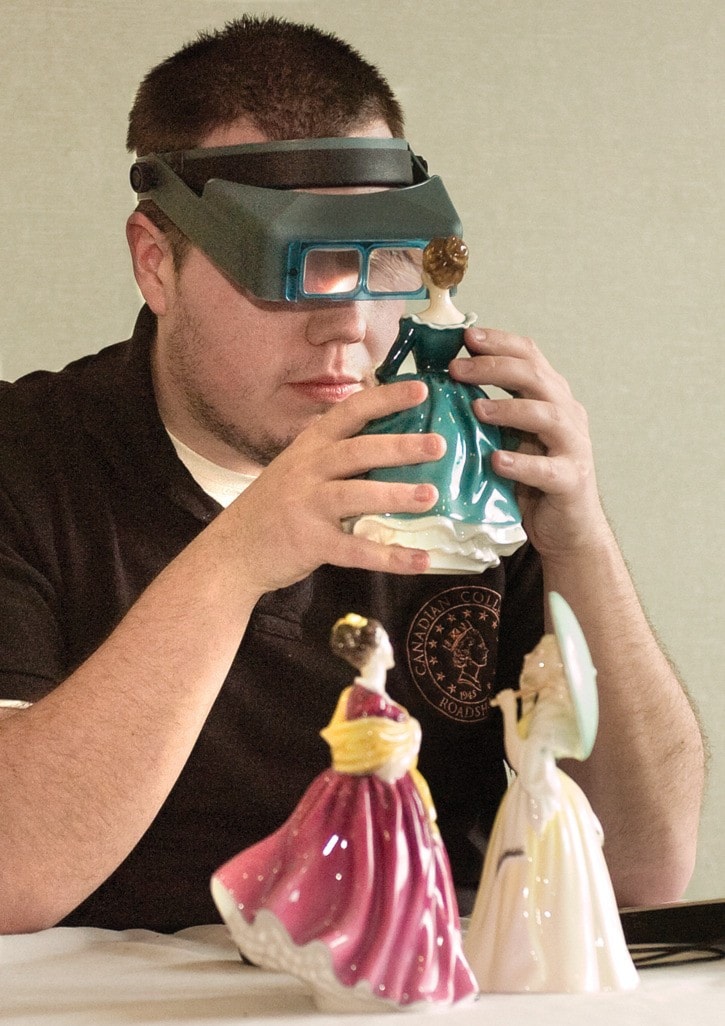Upon walking into Ocean Promenade Hotel’s conference room last Friday morning, one could spot a container filled with teeth, a Nazi dagger and a Beatles poster.
The items were just a few of the countless possessions people brought in for examination by Canadian Collectors Roadshow appraisers, who set up shop in White Rock March 9-12.
The opportunity was too good to pass up for Sharon Annesley of Richmond, who was looking to learn the value of her childhood Campbell’s Soup doll, and Surrey resident Cathy Deakin, who had picked up a 1963 world atlas and an assortment of cutlery when shopping at garage sales and thrift stores.
Although both women left without an offer from the appraisers – who occasionally bought items of interest on the spot – other visitors, such as Peninsula resident Herman Koot, walked away with instant cash.
As people seated along the wall of the room waited patiently for their turn with one of the four experts on-site, Koot placed his valuables on a table for appraiser Rob Viereck to inspect.
A collection of silver Canadian coins, worn foreign bills from the early 1900s and a 1930s watch were some of the items he had inherited from family and decided to sell in an effort to de-clutter his home.
“What do we have here? Oh, we don’t see these every day,” Viereck said as he picked up the watch, which Koot’s grandfather received for his service with the Dutch transit system. “This is very nice. It is plated on the front, so it’s just the back I believe that’s 14-karat gold.”
Viereck, who specializes in Asian and Middle Eastern collectibles, pushed the heirloom to the side for further examination by his colleague, Mark Pender, who has 35 years experience in the business.
While Viereck rejected the bills – “a collector would not want them because of the damage and staining on them” – he took interest in the old coins. Canadian coins dated before 1967, and American coins before 1964, are valued for their silver, Viereck said. Coins prior to ’67 are worth five times their face value; ones dated that year are worth four times, due to a lower silver content.
While coins make up a third of the road show’s business (one-third is gold and silver, and another third is antiques) only Canadian and American coins are accepted, he noted, as it’s more difficult to determine the silver content in other currencies.
“For other countries, it would take an encyclopedic knowledge to look up the percentage of each year,” Viereck said.
Koot said his father collected the Canadian coin after immigrating from Holland in 1954 and becoming “fascinated” with it. Koot ended up pocketing $460 for the collection, which included two 1976 Olympic coin sets Viereck bought for $50 each.
“It’s even more than I sort of expected,” Koot said. “I’m quite content with that.”
South Surrey resident Anne Marie Bourne also had some luck with old gold and silver jewelry she brought in for appraisal. But it was the chunks of dental gold – some of it still in teeth – that raked in the most cash.
“My dad was a dental hygienist,” Bourne explained, noting her father had given her a couple lumps of the gold when she was a baby.
Pender, who weighed the teeth on a scale, said it wasn’t the first time he has had such an encounter – someone recently brought in a tooth that still had blood on it from being pulled the day before.
Bourne received $176 for the dental gold, bringing her total to $296.
Pender joined his father in the field in the U.K. after leaving school at 15 years old, and has since learned to recognize the hallmarks of period pieces. He immediately identified an antique brought into the White Rock show as an 18th century English silver jug.
As for the Nazi dagger, it had been brought in by a woman whose grandfather had taken it from a POW. Pender said the dagger’s lack of detail and decoration indicates it belonged to a low-ranking officer. He plans to sell it for around $400.
One of the more memorable pieces he recently came across was a rare spoon from the late 16th to early 17th century, which he bought for $500 in Nanaimo a few weeks ago. The seller told Pender his chickens had been pecking at a particular spot on his farm, and – after a silver glint caught his eye – he pulled the spoon from the ground.
It was an unusual account, Pender conceded.
Then again, after years in the business one might find that the stories that come in are as interesting as the treasures themselves.
